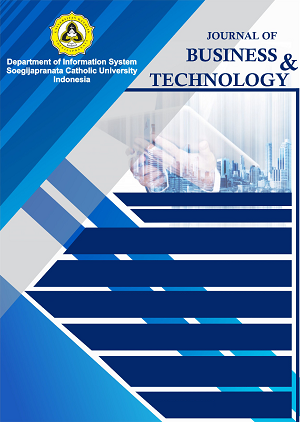Game Design for Eysenck Method Personality Test Using Unity
Abstract
In this day and age, there continues to be a growth in technology that makes things easier and more effective. In addition, the distance that was originally a major problem for connecting, talking, exchanging thoughts or data with others disappeared because of the globalization that occurred. The growth of science and technology is basically a growth that aims to achieve and fulfill human aspirations and needs in using resources. Therefore, the idea arose to design a simple personality test game.
The purpose of this research is to design a windows10 operating system-based game into the "Personality Test" game. Questions from the Eysenck test will be made into the game. This game will be implemented into the game using unity. The method used in research is to collect data by interviewing users to get data quickly.
Keywords
Full Text:
PDFReferences
L. Winoto and J. L. Setiawan, “Hubungan antara Kepribadian Extrovert-Introvert dan Entrepreneurial Self-Efficacy ( ESE ) pada Mahasiswa Jurusan X Universitas Y Surabaya,” J.
Entrep. dan Entrep., vol. 4, no. 1 dan 2, pp. 11–24, 2015.
P. T. Y. S. Suyasa, “Perbedaan Minat Dalam Penggunaan Fungsi,” Digilib.Esaunggul.Ac.Id, vol. 3, no. 2, pp. 89–108, 2005.
R. Yohana, “Hubungan Tipe Kepribadian dengan Prestasi Akademik Mahasiswa Program Studi Kedokteran Tahun 2016 Fakultas Kedokteran Universitas Tanjungpura,” J.
Cerebellum, vol. 49, no. 12, pp. 665–670, 2022.
G. Félix and N. Thomas, Evidence of two effects in the size segregation process in dry granular media, vol. 70, no. 5. 2004.
R. M. Ningsih and S. A. Awalludin, “Analisis Kemampuan Komunikasi Matematis Ditinjau dari Tipe Kepribadian Extrovert dan Introvert,” J. Cendekia J. Pendidik. Mat., vol. 5, no.
, pp. 2756–2767, 2021.
Eysenck, H J and S. B. . G. Eysneck, “Manual of the Eysenck Personality Inventory : [E.P.I.],” p. 24 p., 1963.
D. Chairilsyah, “Metode dan teknik mengajarkan kejujuran pada anak sejak usia dini,” Metod. dan Tek. mengajarkan kejujuran pada anak sejak usia dini, vol. 5, no. 1, pp. 8–14,
T. Ardyanto and A. R. Pamungkas, “Pembuatan Game 2D Petualangan Hanoman Berbasis Android,” J. Go Infotech, vol. 23, no. 2, pp. 14–17, 2018.
A. Suryadi, “Perancangan Aplikasi Game Edukasi Menggunakan Model Waterfall,” J. Petik, vol. 3, no. 1, p. 8, 2018.
J. K. Haas, “A History of the Unity Game Engine,” Worcester Polytech. Inst., p. 44, 2014.
L. S. Mongi, A. S. M. Lumenta, and A. M. Sambul, “Rancang Bangun Game Adventure of Unsrat Menggunakan Game Engine Unity,” J. Tek. Inform., vol. 13, no. 1, 2018.
H. F. A. and S. E. Sohail Aslam1, Maqsood Ahmad2, “BAB 2 PENGERTIAN KEPRIBADIAN,” vol. 7, no. 2, pp. 1–18, 2021.
D. Hurriyati, M. Agustina, and Jemakmun, “Tipe Kepribadian Pegawai dengan Pekerjaan Melalui Teori Eysenk,” Psikologia (jurnal psikologi), vol. 4, no. July, pp. 53–61, 2019.
Aceng Abdul Wahid, “Analisis Metode Waterfall Untuk Pengembangan Sistem Informasi,” J. Ilmu-ilmu Inform. dan Manaj. STMIK, no. November, pp. 1–5, 2020.
Y. D. Wijaya and M. W. Astuti, “Sistem Informasi Penjualan Tiket Wisata Berbasis Web Menggunakan Metode Waterfall,” Semin. Nas. Teknol. Inf. dan Komun., p. 274, 2019.
F. Yulianto, F. Yulianto, Y. T. Utami, and I. Ahmad, “Game Edukasi Pengenalan Buah-buahan Bervitamin C Untuk Anak Usia Dini,” J. Nas. Pendidik. Tek. Inform., vol. 7, no. 3, p. 242,
DOI: https://doi.org/10.24167/jbt.v4i1.10211
Refbacks
- There are currently no refbacks.
e-ISSN: 2776-0332 | View My Stats



